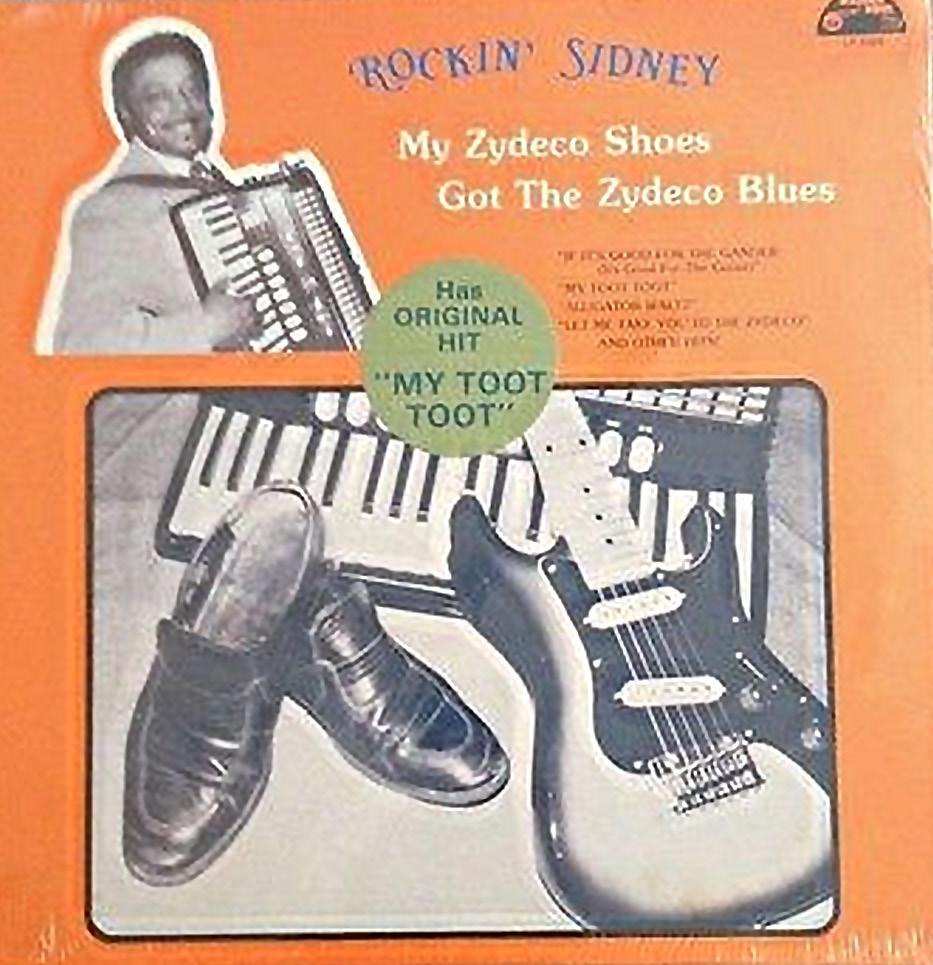
7 minute read
Rockin’ Sidney
Rockin’ Sidney and The Best Selling Zydeco Song of All Time
ichael Tisserand in The Kingdom of Zydeco relates the story of a 10-year-old Sidney Simien in Catholic school when his class is visited by a priest to discuss career choices. Sidney had a dream of becoming a singing cowboy in the movies, but his brothers burst that bubble when they told him no black man could be hired for such a role. The other kids in his class each took their turns to stand up that day to declare they wanted to be a doctor, a lawyer or a farmer. When it was Sidney’s turn to stand, he said, “Well, it’s not what I want to be, it’s what I’m going to have to be. And I don’t believe the Lord can do much about it, either.” The priest asked why, and Simien said it was because he was black. “That’s when the teacher told me to wait in the hall,” he remembered. M
Advertisement
Simien figured the priest was going to hit him. Instead, the priest asked, “You want a soda water?” Then he asked young Simien what he wanted to be. Sidney told the priest he wanted to
be a singing cowboy like Roy Rogers, playing the guitar, cleaning the town, getting the girl, and getting respect. “That’s it!” the priest exclaimed. “You want to be an entertainer.”
Three days later he went back to talk to the priest. “That’s when he turned my life around. He told me to study piano, and he paid for it. I started playing at school, and he started calling churches and booking me. That was Father Mulkeen. He heard some of my records, but he never saw me get famous.”
idney was a professional musician at age 12, and took over his uncle’s band at age 15. After graduating from high school, he began playing clubs and a few years later recorded some regional R&B hits with Floyd Soileau’s Jin label. Then in 1965 he recorded pop and soul tunes on the Goldband label, with some success. The Goldband record producer, Eddie Shuler, thought Sidney could become the next Clifton Chenier, and got him to make a record in French playing harmonica. That record went nowhere. S
Clifton Chenier’s Derision
When he was at a dance, and had had a bit too much to drink, Sidney approached Clifton Chenier to ask him about

buying an accordion. “Man, don’t bother me,” was the terse reply. A little later, he approached Chenier again and asked if he could play harmonica with the band. Chenier picked up the microphone and made an announcement to the crowd of 500 dancers present that Rockin’ Sidney wants to play the accordion and the harmonica. “He kind of embarrassed me a bit.” But the ridicule from the stage that night only fueled Sidney’s desire to out-do Chenier with a bigger stage presentation of his own. He made a couple zydeco albums, and had his first regional hit, “If It’s Good for the Gander.” The song became a showstopper in local clubs, where Simien

would parade in a goose made up with lipstick and earrings on a leash. “I knew the first thing a goose does when it gets to a door is it wants to go in, so I’d go by the women’s bathroom, and the house would go wild.”
In 1982 the main event at the Texas-Louisiana Blues and Zydeco Festival was the “battle for the crown of zydeco” featuring both Clifton Chenier and Buckwheat Zydeco. That gave Simien the idea for his next act. He fashioned a Clifton Chenier costume with a wig, a cape and plastic gold teeth, studied ventriloquism and got a Buckwheat Zydeco dummy to take on stage, and impersonated them both doing their hit songs. “Buckwheat stayed mad at me a long time. But that’s what made me real popular. And actually Clifton Chenier and Buckwheat both would catch my show to see if I was going to do them. So when Cliff would come, I would do Buckwheat, and when Buckwheat would come, I’d do Cliff.”
The Story Behind the Lyrics of “Don’t Mess With My Toot-Toot”
It was late at night in 1982 that Sidney would compose the zydeco song that would be the sensation of 1985 and still be the blockbuster hit of all time more than three decades later. He set about recording the song “Don’t Mess With My Toot-Toot” in his garage playing all of the parts himself. The story told in The Kingdom of Zydeco of how Sidney came up with the lyrics is hilarious.
Before playing a song, Chenier would say “Eh toi, fais attention,” or ‘Hey, you, pay attention’.” Cajun bands would often comment from the stage, “Fais pas ça,” “Don’t do that,” and introduce a song in French, with “ma chére tout-toute”, or “my sweet little everything.”
“Well, I don’t speak French,” admitted Simien, “so what I’m hearing is, “Blah-blah-blah-blah-toot-toot.”
“So then I sang it one time and made a bunch of mistakes on that thing. One place I said, ‘C’est pas ça’ but it’s supposed to be ‘Fais pas ça….’ Now it turns out the Spanish people would think I was trying to sing, ‘¿Qué pasa?’
“I thought I would be clever with my words and change

them around, because I used to like the way Chuck Berry would write…. So I said, ‘You can look as much, but if you much as touch.’… I got the idea that I was going to let people try to figure out what I was trying to say. I said, ‘She was born in her birth suit, the doctor slap her behind.’ I thought that was a clever thing, but nobody ever questioned me about that.”
he song “Don’t Mess with My Toot Toot” was released in 1984 by Maison de Soul as the “B” side to “My Zydeco Shoes Got the Zydeco Blues.” It wasn’t long before the the B side was being played by Cajun stations, and then country stations, and then top 40 stations when Casey Kasem played it. And then it was picked up and re-recorded in Europe, but made the biggest splash in the Latino community. The elusive meaning of the term “Toot Toot” fueled much of the song’s appeal.
Herman Fuselier revisited the phenomenon of “Don’t Mess with My Toot Toot” in his Advertiser article, “Thirty years after ‘My Toot Too,’ zydeco seeks more gold”. Fuselier wrote, ’Toot Toot’ was soon leased to Columbia Records for national distribution. The tune leaped into the country music’s Top 20 and clocked its first million in sales. Simian enjoyed instant celebrity, appearing on “Hee Haw,” “Austin City Limits” and T
other national TV programs. Other artists cashed in. Jean Knight, Denise La Salle, Fats Domino, Doug Kershaw and John Fogerty of Creedence Clearwater Revival fame recorded cover versions. Some scored hits, but none as big as the popular Colombian group, La Sonora Dinamita. They achieved million sellers with two Spanish versions, ’Tu Cucû” in 1988 and “No Provokes mi Zichichi’ in 1989.”
When asked on a television broadcast what a toot toot is, Rockin’ Sidney said, “It’s a hit record,” which got a lot of laughs. He went on to explain it’s a Cajun-Creole saying for a little baby, a girlfriend or a sweet person that you love. That went over well with the fans because at first a lot of people thought it was a risqué record, but it had nothing to do with that.
Will There Ever Be Another Million Seller?
Many artists dream of scoring zydeco’s next gold record, but despair that the music industry has changed so much that it’s impossible.
Sean Ardoin created a stir with a zydeco version of Pharrell Williams’ “Happy,” and said it’s not about record sales in record stores or in jukeboxes anymore but about Twitter, Facebook, Instagram and YouTube. “Before you had to work really hard for
one person to see you so he could sign you,” said Ardoin. “Now you’ve got to work really hard for everybody to see you.”
Ted Fox, manager of Buckwheat Zydeco for three decades, helped his artist achieve a lot of firsts including a recording contract with a major label and performances with U2 and Eric Clapton. According to Fox, “The likelihood of another zydeco million seller is tiny. It’s tiny for anybody in any genre these days…. Some of the vintage Buck clips [on Youtube] have over a half million views, which means over a half million listens.”
There is reason for optimism though in the popularity of songs like “The Cupid Shuffle,” Fuselier reported. Since its release in 2007, the song has had more than 3 million in sales. The song even mentions zydeco in its opening lyrics. The song has become one of the all-time most popular line dances, attracting dancers to the floor immediately from the opening “boom.”
Fuselier quoted Ted Fox in his article: “[Cupid Shuffle] to me was just as strong as ‘Toot Toot,’ in its own way, and it’s still going. We have some great young, and older, minds in zydeco. Anything is possible.”
For more to this story, read “Thirty years after ‘My Toot Toot,’ zydeco seeks more gold” by Herman Fuselier in The Advertiser (March 20, 2015), and The Kingdom of Zydeco by Michael Tisserand (Arcade Publishing).



